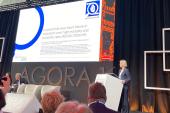NT-proBNP Cutoffs for HFpEF Diagnosis May Need Tweaking
Obesity influences the thresholds, but even in nonobese patients with dyspnea, optimal cutoffs may be lower than recommended.

For patients with chronic unexplained dyspnea seen in the outpatient setting, the optimal thresholds of plasma NT-proBNP currently used to diagnosis heart failure with preserved ejection fraction (HFpEF) may differ from what’s currently recommended, a new study suggests.
Cutoffs may need to be lower in patients with grade 2 or higher obesity to optimize sensitivity and specificity. For outpatients with dyspnea and atrial fibrillation (AF), NT-proBNP levels may not be very useful at all because “AF itself is a robust biomarker of HFpEF,” lead authors Yogesh Reddy, MBBS, and Atsushi Tada, MD (both from Mayo Clinic, Rochester, MN), and colleagues report.
Senior author Barry Borlaug, MD (Mayo Clinic), said that even among nonobese patients, the NT-proBNP cutoffs need to be lower to rule out disease.
“We did the study because we have seen time and again anecdotally that [the recommended threshold] doesn’t work, that frequently patients with true HFpEF that we’ve diagnosed definitively by invasive assessment have normal NT-proBNP levels or levels that are much lower than what are considered by some to rule out the disease,” Borlaug said. “What we found confirmed that anecdotal observation.”
The findings were published online recently in Circulation.
Natriuretic Peptides in the Outpatient Setting
Natriuretic peptides—whether B-type natriuretic peptide (BNP) or NT-proBNP—have long been used in the diagnosis of heart failure with reduced ejection fraction (HFrEF).
However, “no one has really tested how well these work in [the setting of HFpEF] and the few studies that have tested used expert consensus to make the diagnosis of whether HFpEF is present or absent in place of the gold standard, which is invasive exercise testing,” said Borlaug. Most studies, too, have focused on patients seen in emergency rooms or hospitals, and not ambulatory patients.
For the current study, the investigators examined use of various NT-proBNP thresholds for diagnosing HFpEF or noncardiac dyspnea in a derivation cohort of 414 patients with chronic dyspnea and in three validation cohorts ranging in size from 77 to 560 patients. HFpEF was definitively identified using exercise right-sided heart catheterization.
After identifying optimal cut points, the researchers evaluated their performance in three additional validation cohorts in which HFpEF was diagnosed with resting catheterization only (n = 260), a previous hospitalization for heart failure (n = 447), and exercise echocardiography (n = 517).
If you really want to rule it out, you’ve got to go down to values of 50 or even 30 to truly exclude HFpEF. Barry Borlaug
The currently recommended NT-proBNP threshold for ruling out HFpEF is less than 125 pg/mL, and this provided 77% sensitivity in this study—82% among patients with a body mass index (BMI) < 35 kg/m2 and 67% for those with a BMI ≥ 35 kg/m2. A lower rule-out threshold of less than 50 pg/mL provided improved sensitivity for patients both below and above that BMI level (97% and 86%, respectively).
When looking at thresholds to rule in HFpEF, a cutoff ≥ 500 pg/mL provided 85% specificity for patients with a BMI below 35 kg/m2. A lower rule-in threshold of ≥ 220 pg/mL provided comparable specificity (88%) in patients with grade 2 or greater obesity.
These findings were consistent in validation cohorts.
Nearly all patients with a history of AF in the current study (98%) also had HFpEF, so NT-proBNP levels didn’t provide any additional discrimination.
Changing Thresholds
Although an NT-proBNP threshold of less than 125 pg/mL has been considered useful to rule out HFpEF in a patient with dyspnea, “we show that that’s clearly not the case, especially for people living with the obesity phenotype of HFpEF,” Borlaug said. “And if you really want to rule it out, you’ve got to go down to values of 50 or even 30 to truly exclude HFpEF. So this really changes things, I think, in terms of the diagnostic evaluation.”
He underscored the importance of getting this right.
“In the past, it wasn’t such a big deal to miss the diagnosis of HFpEF because we didn’t have clearly proven effective treatments. But now we do; we have several treatments that are very effective,” he said. “So we really need to do a better job of identifying these patients. And if we want to identify them, we need to be cognizant of what NT-proBNP levels can rule in or rule out HFpEF, and which are indeterminate.”
The thresholds should be adjusted based on the presence of obesity if clinicians want to rely on NT-proBNP for the diagnosis, Borlaug said. But he also called for additional research into other biomarkers that might be better suited to this purpose.
He noted that his group has published research on two other neurohormone biomarkers, endothelin-1 and adrenomedullin, which both performed well for discriminating patients with HFpEF from controls, and weren’t affected by obesity. He added, however, that “we need much bigger studies, preferably multicenter studies with invasively proven and disproven heart failure.”
Todd Neale is the Associate News Editor for TCTMD and a Senior Medical Journalist. He got his start in journalism at …
Read Full BioSources
Reddy YNV, Tada A, Obokata M, et al. Evidence-based application of natriuretic peptides in the evaluation of chronic heart failure with preserved ejection fraction in the ambulatory outpatient setting. Circulation. 2025;Epub ahead of print.
Disclosures
- Borlaug reports being supported in part by grants from the National Institutes of Health (NIH) and the US Department of Defense; receiving research grant funding from AstraZeneca, Axon, GlaxoSmithKline, Medtronic, Mesoblast, Novo Nordisk, and Tenax Therapeutics; having served as a consultant for Actelion, Amgen, Aria, BD, Boehringer Ingelheim, Cytokinetics, Edwards Lifesciences, Eli Lilly, Janssen, Merck, and Novo Nordisk; and being named along with one of his co-authors as inventor on a patent for the tools and approach for a minimally invasive pericardial modification procedure to treat HF.
- Reddy reports being supported by an NIH grant; research grants from Sleep Number and Merck; Bayer Accelerated Pulmonary Hypertension Award; United Jenesis Award; and Earl Wood Career Development Award from the Mayo Clinic Cardiovascular Division.
- Tada reports being supported by a research fellowship from the Uehara Memorial Foundation, Japan.






Comments